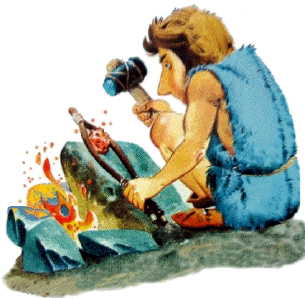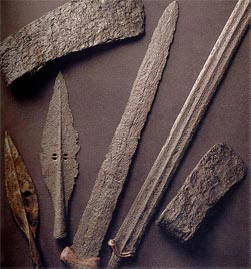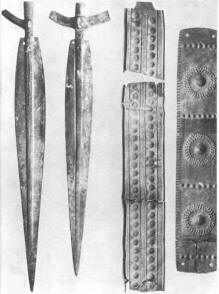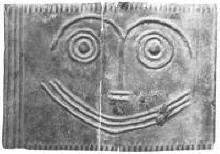Age of Metals and Development of Metallurgy in the World and in Sicily
Copper Age (in Sicily about 3500 BC)

 We can imagine, with a certain amount of imagination, the following scene: an ancient exponent of the stone civilization decided to make a knife, he went in search of a stone so that he could appropriately chip it until he reached the desired purpose. At one point he found a strange stone, he tried to hit it but found that instead of chipping it his blows could only make him change shape. The man did not realize that from a man of the Stone Age he had become one of the first men of the Copper Age, he had in fact discovered copper in its pure state. The former stone age man soon realized that he could use such metal to build small objects for ornaments or for religious uses.
We can imagine, with a certain amount of imagination, the following scene: an ancient exponent of the stone civilization decided to make a knife, he went in search of a stone so that he could appropriately chip it until he reached the desired purpose. At one point he found a strange stone, he tried to hit it but found that instead of chipping it his blows could only make him change shape. The man did not realize that from a man of the Stone Age he had become one of the first men of the Copper Age, he had in fact discovered copper in its pure state. The former stone age man soon realized that he could use such metal to build small objects for ornaments or for religious uses.
In Sicily the advent of the copper age occurred towards the middle of the fourth millennium BC, in fact traces that would testify the use of copper objects already in this period have been found in Lipari [1]. In other areas of the world, the advent of metallurgy occurred much earlier. In a cave ofIraq a copper bead was found worked by an unknown craftsman of 11.000 years ago [2]
Initially, the processing technique consisted of cold hammering of pure copper from strands or nuggets. In a second phase, man learned to heat native copper, even if the real age of metals will begin only after thousands of years, when the procedure for extracting copper from the materials that contain it will be discovered with the The use of furnaces capable of producing melting temperatures of about 700 degrees centigrade. This in the initial phase of the copper age, subsequently there were kilns capable of working at about 1000 degrees centigrade, obtaining a quantity of copper for use on a large scale [3]
The Middle East, therefore, at least at that time, was certainly at the forefront in the field of technology, in fact, based on archaeological findings, we come to the conclusion that it had preceded the rest of the world in metalworking. In Anatolia it seems that the smelting of copper by means of high-temperature furnaces took place in the VI V millennium BC
A 2014 discovery gave further evidence to this hypothesis.A copper weevil traceable between 5100 and 4600 BC was found at Tel TSAF, an archaeological site in Israel. The scientists detailed their findings online in the journalPLoS One [10]
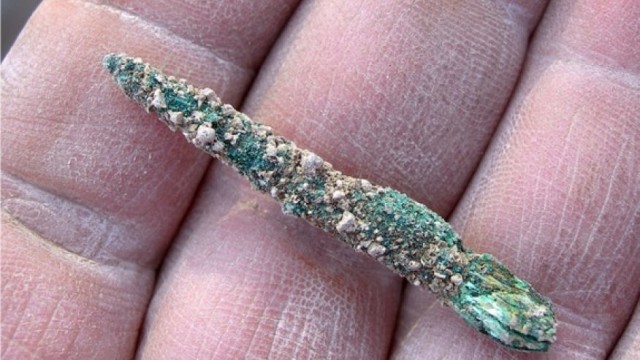 Copper awl discovered at Tel TSAF
Copper awl discovered at Tel TSAF
Towards 3.000 BC the man of the Middle East was already able to produce bronze (alloy of copper and tin), and in 2700 he had furnaces in which the temperatures reached could be those necessary for the smelting of iron [4].
In Europe, the so-called "Popoplo dei Campaniformi Glasses”, Originally from central Europe and whose name is due to the shape of the clay vessels found in many burials relating to this people, their cultural influence was also felt in Italy, especially in Sardinia and western Sicily [5].
Thanks to the birth of metallurgy we are witnessing the first real "industrial revolution". Copper is the first of the metals to be worked, followed by bronze and finally iron.
Axes arrows and knives from the metal age From the site: www.ulisse.rai.it
Initially, copper working will be used for the construction of cultic objects [6], then, with the increased work experience, also for everyday objects and, subsequently, for war use. The increase in population was supposed to favor the war activities necessary for the conquest of new territories but also to defend those conquered. Numerous are the findings of daggers and arrowheads, used for hunting but also for war activities.
Mendolito's closet - Adrano. C.uspidi of spears and belts (from Bernabò Brea 1982)
The quality of the copper objects was certainly not the best, and this is because the copper castings, precisely because of the type of processing used, did not always succeed perfectly, the mineral was never actually pure but contained traces of other elements such as iron, arsenic and lead. The final result strongly depended on which impurities were present and in what quantity. For example, lead made the obtained material soft, while arsenic in certain quantities made the quality of the obtained copper better.
Bronze Age (in Sicily about 2300 BC)
While not knowing what chemistry was, the metallurgists of the time had to pay attention to these things. In fact at a certain point they decided to enrich copper with arsenic, creating bronze which at the beginning was therefore an alloy of copper and arsenic.
Mendolito's closet - Adrano. Armor fragment (from Bernabò Brea 1982)
Over time they learned to replace arsenic with tin, much less dangerous than the first. The final product was a much stronger metal and of a higher quality than wrought copper. This meant that the uses of metal objects that ceased to be a luxury item soon increased considerably. Bronze was used to build religious and ornamental objects, weapons and everyday objects, becoming an inevitable element in the grave goods of the wealthiest.
During the recent (1300 BC) and final (1200 BC) bronze, the development of metallurgy involves the improvement or even the invention of working tools (new types of axes, sickles, chisels, saws) and also tools for personal use (razors, fibulae, tableware).
A Pantalica in what is called “anaktoron” an area for metal processing has been identified [7]. In the Hyblean territory, a Giarratana in locality Woman Scala come a large amount of bronze material (over two quintals in weight) now preserved in the museum of Syracuse [8]
Iron Age (in Sicily about 1000 BC)
Iron was among the metals, the last to be worked, due to the difficulty in obtaining furnaces that reached the temperature of 2000 degrees centigrade which was the temperature necessary for iron to melt. Also while it was easy to find native copper the rarer is the possibility of finding iron in its natural state. We could say that it did not fall from the sky every day and this not to make a joke but because actually real mines were made up of meteorites. The Sumerians, who in the third millennium BC were the first to work iron, not surprisingly called it "celestial metal" In Sicily already in the final Bronze Age, in the necropolis of Badia mill, the use of iron is documented [9]. The official period in which the Iron Age begins in Sicily is from the XNUMXth century BC
End of Prehistory and beginning of History
From this moment on, archaeological research finds, and in turn gives, support to the historiographic tradition. It is the period in which ethnic groups acquire that numerical and cultural consistency that can now speak of sovereign peoples on territories with more or less delimited borders. The inhabitants of Sicily of this period, described later, are called: Sicani, Sicilians, Morgeti e Elimi. Among the first historians who made contributions to the knowledge of the first peoples who inhabited the island are to be remembered: Thucydides, Diodorus of Sicily, Strabo and Dionysius of Halicarnassus.
[1] Claudio Giardino: Metallotechnics in pre-protohistoric Sicily. In First Sicily pag. 405
[2] Jonathan Norton Leonard: The first farmers p.111.
[3] Joan Santacana: The first companies. p.60.
[4] Percy Knauth: The discovery of metal. p. 21.
[5] Percy Knauth: The discovery of metal. p.60, Joan Santecana: The first companies. p.70.
[6] The two copper daggers found one in the Grotta della Chiusazza (Syracuse) and the other in a tomb near Sciacca had to be used for ritual purposes.
[7] Guidi and Piperno: Prehistoric Italy p.482
[8] Luigi Bernabò Brea: Sicily before the Greeks p.199
[9] Guidi and Piperno: Prehistoric Italy p.493
10) Article: The Beginning of Metallurgy in the Southern Levant: A Late 6th Millennium CalBC Copper Awl from Tel Tsaf, Israel on PLoS One http://journals.plos.org/plosone/article?id=10.1371/journal.pone.0092591

Adapted from History of Sicily by Ignazio Caloggero


